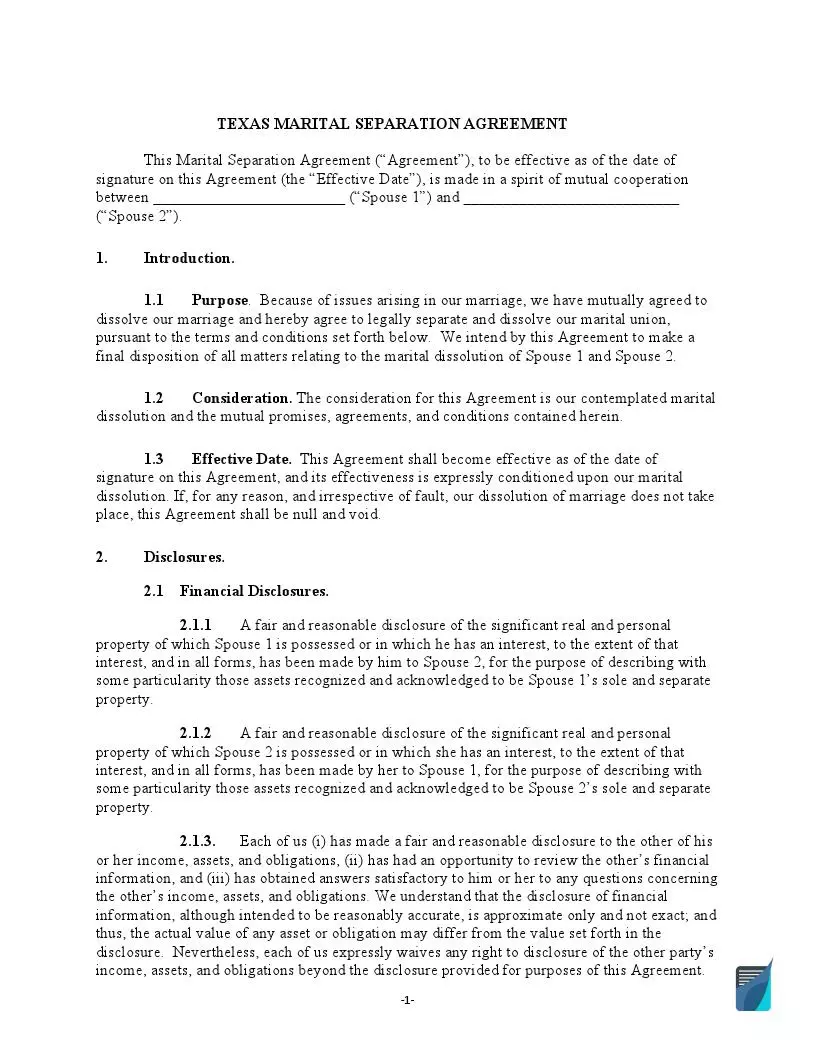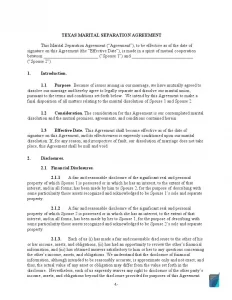Texas Marital Settlement (Divorce) Agreement and Legal Separation
Couples are not always destined to be together, and when disagreements take over, the question of divorce arises. In Texas s, divorcing couples can use the Texas Marital Settlement Agreement (also called a separation agreement) to resolve all occurring disputes.
Some divorces occur in harmony and friendship; former lovers agree on an amicable breakup and independently accept all agreements on children’s custody, division of property, and other formalities. In contrast, others are ready to create a scandal out of nothing and require professional legal assistance. In such a case, you are encouraged to use the family attorney’s help to communicate. The Texas free marital agreement form documents all agreements and makes them legal.
Divorcing couples sign this agreement to outline their decisions regarding the division of their assets, custody of children, payment of debts, and whatever they see fit to include in the document.

Build Your Document
Answer a few simple questions to make your document in minutes
Save and Print
Save progress and finish on any device, download and print anytime
Sign and Use
Your valid, lawyer-approved document is ready
Both spouses must sign the agreement in the presence of a notary public agent who later certifies the document. Any coercion to sign this agreement is not allowed; signatories must draw it up and sign it voluntarily. It is advisable to show the agreement to an independent expert before signing it or use a lawyer’s or family law attorneys’ services when drafting it.
If the spouses remain on friendly terms after divorce and can easily agree on respective family matters, it is possible to get by with an independent expert. But often, divorce is a complicated matter and nerve-racking issue, so you cannot do without lawyers. It is beneficial to use marital settlement agreements because they reflect all of the divorced couple’s expectations, rights, and responsibilities in writing. The agreement removes misunderstandings, ensuring that both spouses are on the same page.
Suppose the agreement is formalized legally (below, we will discuss the laws governing divorce in Texas). In that case, the court will accept it and follow it to split property and responsibilities. Otherwise, the court will follow state law. We suggest using our form-building software to complete a marital settlement agreement in Texas. You will find detailed information on our website.
Contents of a Marital Settlement Agreement
There is no single approved sample by which an agreement should be drawn up; different options are possible. However, a marital settlement agreement always contains the following points:
General Information
The agreement must contain information about the spouses, their full names, wedding date, and date of separation. You also need to note whether one of the spouses is currently serving in the Armed Forces. It is also worth mentioning the presence of children.
Spousal Support
Sometimes, one spouse decides to support the other financially after a divorce. In this section, it is worth indicating the amount to be paid and for how long. One spouse can also cover the other’s insurance.
Property Information
It is necessary to indicate whether they own joint or individual property and document each spouse’s obligations. It is also worth declaring the intention to change the name here (for example, the wife can decide to revert to the maiden name).
Additional Terms
It is also necessary to include all additional agreements reached during the negotiations.
Date and Signature
Both spouses must sign next to their full names and indicate the current date. Signing is voluntary, without coercion or intimidation. Otherwise, the court will recognize the document as invalid.
Attachments
Attachments include further separation of spousal support, child custody, property, and both signatories’ liabilities. You can specify the agreement’s terms in more detail in this section.
Texas Divorce and Separation Laws
It is essential to know the laws of the state regulating divorce. In the absence of a marriage settlement agreement, the court will rule on the divorce, separation of property, duties, and custody according to the law. In Texas, this process is governed by TX Family Code (Subtitle C). Below, we will look at some of its points.
Grounds for Divorce
All legal grounds for divorce in Texas are listed in Chapter 6.001-6.007 of the subject Code. They include the following:
- Insupportability. Personal disagreements, irreconcilable differences
- Adultery. Cheating
- Abandonment. The absence of one of the spouses for at least a year, leaving the other alone
- Cruelty. Unbearable living conditions
- A crime committed by one of the spouses, leading to imprisonment for at least a year
- Mental hospital confinement for a minimum of three years
- Separate residence for a minimum of three years
Property Division
It is worth studying Section 7.001 to understand the division of property laws in Texas. If you have failed to make an independent decision, the court will be guided by the principle of a fair and correct division when reviewing your particular case.
According to the Texas Community Property Law, all property is considered common if it was acquired during the marriage. However, a spouse can prove that the property belongs to them only. For example, property owned by someone before the marriage is considered personal property.
Child Custody and Visitation
The laws governing this clause are stated in Chapter 153. Typically, a Texas court decides on joint custody, under which a child spends at least 35% of the time with each parent per year. Sometimes, the court rules on sole custody, according to which the primary parent makes all decisions regarding the child.
There is also the option of split custody. With this option, the couple must have at least two children, and each parent is given custody of one of the children. Sure, it is a tough decision to make, but a crucial one. It is worth mentioning a commonly accepted practice in Texas by which the parents must attend parenting courses during the divorce. In our opinion, it is a good practice that makes divorce not such a scary event for children and helps all participants cope with their new life.
Child Support and Alimony
Child support and alimony amounts are charged depending on income and ability to pay.
Support is calculated from the income of the parent who has not received child custody.
It is believed that the parent who takes care of the child already bears the costs of supporting the child. Therefore, the second parent is obliged to help by paying alimony and support. This parent can pay an amount more than the court decides, but not less. You can learn all the respected principles from Section 153.001 of the Texas Family Code.
Popular Local Marital Settlement Agreement Forms
A marital settlement agreement, often known as a property settlement agreement, is a powerful instrument that can help you work out the divorce proceeding and eliminate major hassle. The following are the states the people of which search for this form the most.
Legal Separation
Legal Separation is a divorce in essence, but not by law. It is sometimes issued for religious reasons, but there is no legal separation in Texas.
Therefore, spouses who no longer wish to live together have to file for divorce. But, if they have reached an agreement by themselves, they can file an uncontested divorce. An uncontested divorce process is faster and easier as it is based on a signed marital settlement agreement.

Filing for Divorce in Texas
If you have decided to get a divorce, there are specific steps to take. If you are filing for a divorce by mutual consent and agree on all the details, the process will be easier for both parties. However, the court will determine the case if there are fundamental disagreements. Please pay attention to the steps you will have to take in the section below.
1. File an Original Petition for Divorce
The side that initiated the process (the plaintiff) must fill out and file the Original Petition for Divorce to the respective authorities. They might also need to perform additional paperwork and file it with the court. Copies of the documents are then transferred to the defendant.
The petitioner can also request a temporary restraining order from the court. According to this order, the court prohibits transferring the couple’s assets and requires respect for each other. If the court issues such a warrant, the hearing will be scheduled within 14 days by the general rule.
2. File an Answer
The defendant is given 20 days to file an official response (unless there is a restraining order). Usually, the court will issue interim orders for custody of children or use the property during the response time.
3. Make a Marital Settlement Agreement
Spouses should disclose all the necessary information about each other in person or via their lawyers. They can use this information to compile their marital settlement agreement. If you manage to agree without a third party, this agreement will facilitate the divorce process.
A marital settlement agreement is not a mandatory document, but it is always worth trying to negotiate before heading to court. You can sign such an agreement at any stage of the divorce.
If the state authorities accept your application and agreement form, the family law attorney of either side should prepare an Agreed Decree of Divorce. This document contains the contract’s terms and requires the spouse’s, attorney’s, and the judge’s signatures. If disagreements remain, the couple has to proceed through the courts.
4. Prepare a Testimony
If the case goes to the court’s consideration, the plaintiff must prepare a Sample Testimony. Sometimes the judge asks for oral testimony, but a written statement will not be superfluous; it can be attached to the case instead.
5. Finalize the divorce
The date of the hearing is set no earlier than 60 days, which are given for considering decisions and signing of agreements.
At the hearing, the court reviews all submitted documents and agreements, if any, and makes its decision. The judge signs the final decree, and the divorce is final. If the couple disagreed and there is a conflict, the divorce case can last more than a year.

Looking for more Texas documents? We offer free forms and straightforward customization experience to everyone who would love less hassle when coping with papers.
Other Marital Settlement Agreement Forms by State